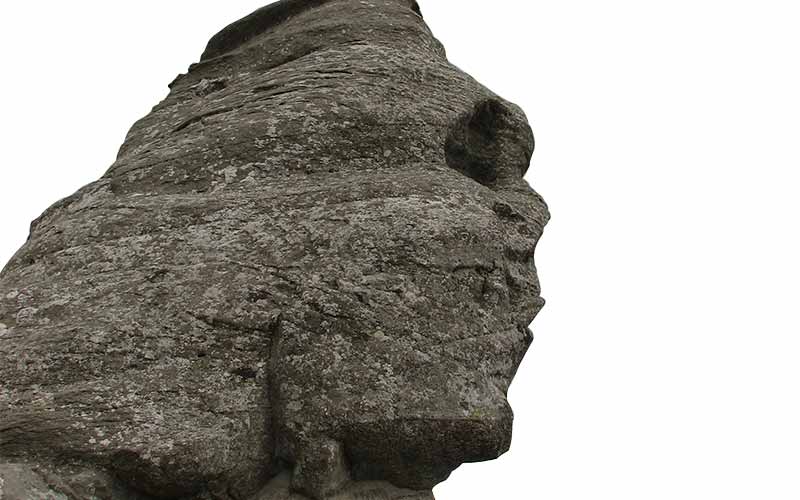Endoscopic Subperiosteal Face Lift
THE GOAL:
To tighten and reposition sagging tissues in middle third of the face causing a “drawn-out”, tired, aged or angry appearance.
Terminology
A number of procedure variations fall under the rubric of face lift. To clarify:
FACE LIFT (rhytidectomy) is the classic term for a lower face lift, involving the lower third of the face only plus the neck. It includes recontouring the underlying structure by removing excess fat and tightening sagging muscles, followed by redraping of the skin.
MID-FACE LIFT (subperiosteal face lift) refers to the middle third of the face, that is, the area around the nose, beneath the eyes and around the mouth. This state-of-the-art operation is performed through a small 2 cm incision made behind the each temporal hairline and within the mouth; it is made possible by the use of an endoscopic (and microscopic) camera to guide the specialized curved instruments used by the surgeon.
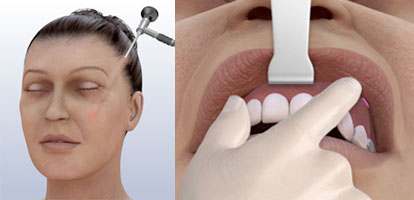
The purpose is to elevate rather than tighten or stretch the total soft tissue mass of the cheek, upwardly shifting the cheek fat pads that give the face its youthful shape and volume. Results are extremely natural and long-lasting. The above can be performed individually or at the same time as other procedures. Patients may choose to have a face lift in conjunction with other rejuvenating procedures such as a brow lift, eyelid surgery, lip reshaping surgery (e.g. upper or corner lip lifts), fat transfer or nose reshaping. Indeed, Dr. Haworth may sensitively recommend these if he feels it appropriate.
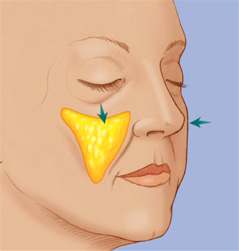
Elevates the sagging cheek mass back onto the cheek bones proper where they originally were in youth. Those patients with flatter cheek bones tend to manifest drooping cheeks sooner than those with “strong” cheek bones. When the cheek fat sags it accumulates around the level of the nasal tip especially noticeable from a 3/4 or oblique view, imparting a “drawn-out”, tired appearance.
- Recreates higher, more glamorous cheekbones by lifting the malar fat pads onto the cheek bones which are postioned laterally.
- Reshapes the total face into a young heart or diamond-shape which is inherently shorter in appearance than an older, more rectangular-looking face.

Rejuvenates the lower eyelid by restoring the malar fat pads to their proper position against the lower eyelid rim, thus reducing any hollow look (often referred to as “tear troughs”) that may have deepened over time. Dr. Haworth may feel that additional procedures of fat transfer along with a lower blepharoplasty would complement the midface lift in an elegantly synergistic fashion. Refer to the eyelift procedural section for more details.
- Elevates the lateral end or tail of the brow to minimize hooding of the outside aspect of the upper eyelid. Dr. Haworth may customize his internal surgical maneuvers during the endoscopic midface lift in order to achieve this effect.
- Improves the shape of the lower eyelid especially if it appears sad or droopy at its outer end exposing excess white of the eyeball. This situation may be congenital or an unfortunate result of past eyelid surgery. Dr. Haworth may customize his internal surgical maneuvers during the endoscopic midface lift in order to improve this look so that more almond-shaped eyes are created.
- Elevates the oral region, albeit in a subtle manner. Dr. Haworth supplements his midface lift with a small unique technique to elevate not only the upper lip and its corners, but also the lower lip to help cover the lower teeth. The upper force of the cheek lift partially transfers onto the lip complex including its corner and lower end.
Close-up view of patient 4 years after midface lift and lower blepharoplasty
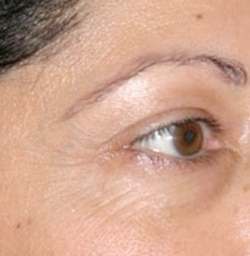
Before
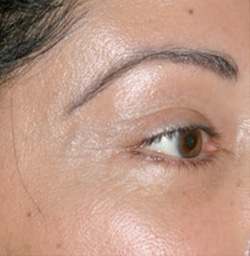
After
One year after midface lift and rhinoplasty

Before

After
CANDIDATES
The most likely candidate for a mid-face lift:
- is 33 years old or older.
- is a patient who notices sagging around the nose, eyes and corners of the mouth but is not yet ready for lower face lift surgery.
- is a patient who feels that their midface is too long and their cheek bones rather flat. He or she may also complain that their lower eyes look hollow and that they have extra tissue accumulating around their nasolabial folds.
- is an older patient who wishes to have the mid-face rejuvenated in conjunction with a lower face lift and/or brow lift.
EXPECTATIONS
Of course, individual results can vary, but a mid-face lift can deliver a smooth, fresh, rejuvenated look that will last for years. However, as time goes by and gravity takes its toll, patients may want to have subtle revisions done down the road. Eventually, a classic facelift will be needed when significant jowls and an aging neck will be of particular concern. Refer to the facelift procedural description for further details.
What a mid-face lift cannot do on its own is:
- Correct loose skin in the neck or significantly firm a jawline
- Reduce jowling
- Completely eliminate naso-labial folds or eyelid hollows
- Restore contour, definition and volume to the lips
OLD THINKING VS. NEW TECHNIQUES
Dr. Haworth is world renowned for his endoscopic mid-face work and has performed them throughout the globe. In general, mid-face lifts have become significantly more sophisticated than in generations past, resulting in more natural yet dramatic and long-lasting outcomes than ever before.
These breakthroughs include:
- EARLY ALTERNATIVE: It’s not unusual for the middle third of the face (measured from the lower eyelids to the corner of the mouth) to age sooner than the lower face. Signs of this process include sagging cheek fat with pronounced nasolabial folds, loss of cheek bone height, hollow lower eyelids and an eleongated face. A mid-facelift can address these changes without the patient having to go in for a classic face lift with its attendant, potentially visible scars.
- ENDOTINE MIDFACE™ ST: Dr. Haworth has been using Endodine technology for mid-face lifts for over six years with superb results surpassing those achieved with sutures. Manufactured by Coapt Systems Inc., Endotine systems represent a real breakthrough in soft tissue repositioning and healing. In short, Endotine are rapidly imperceptible tined implants that secure soft tissue in place of interior suturing. This means little to no trauma to the surrounding tissue, faster surgery time, faster healing, smoother healing and virtually no scarring. Even more extraordinary, the material itself is bioabsorbable meaning that as the tissue securely heals in its new position, the implant itself gradually and safely reabsorbs into the body, leaving no traces of itself behind.
- ENDOSCOPIC MICRO-INCISIONS: The advent of endoscopic techniques (enlisting tiny cameras and elongated narrow instruments) have enabled plastic surgeons to carry out the mid-face lift through the smallest incisions above the hairline and inside the mouth. This results in far less scarring and a far quicker recovery.
- ADDED BENEFITS: Dr. Haworth is an expert in detailed, unique endoscopic tissue release to harness the maximum potential of the midface lift. He can not only lift the cheeks, but also alter the shape of the eye, affect the appearance of the mouth and influence the arch of the brow through the 4 hidden incisions.
PRE-OPERATIVE CONSULTATION
The pre-operative consultation is where you meet with Dr. Haworth and our staff to review your health, finalize the details of your procedures, order appropriate tests, prescribe medications, discuss your aftercare and answer any questions you may have. All patients are required to take a blood test a few days before surgery, which you can do at the same time as your pre-op consultation. All patients are required to take standard blood tests within 6 weeks of surgery. This can be arranged at the same time as your pre-op consultation.
To the consultation, we ask that you bring the following if possible:
- Any appropriate health records related to the list of conditions noted above.
- Photographs of you when you were in your teens, twenties and thirties.
For patients over 45, we may also require that you provide the following:
- full medical clearance
- EKG
Alternatively, we can coordinate this for you.
CRITICAL PRE-OP CAUTIONARY NOTE
It is absolutely essential that that you avoid all aspirin, aspirin-related, ibuprofen or blood-thinning medications for 2 full weeks prior to your surgery. In your pre-op consultation, we will give you a complete list of these drugs. For our patients, we also provide a password-protected link allowing you to download the list onto your computer. If in doubt about a specific medication, do not take it, call the office first and ask if it is on the forbidden list.
If your hair is very short, you might want to let it grow out before surgery, so that it’s long enough to hide the scars while they heal.
PROCEDURE AND RECOVERY LOGISTICS
SURGERY DURATION: 1.5 hours
ANESTHESIA: General or sedation (“twilight sleep”) we will do everything we can to keep you comfortable. An anti-emetic (against nausea) medication is also administered while you are asleep. We not only provide pain medication to control what little pain you may experience postoperatively, but you will be additionally prescribed anti-anxiety, anit-nausea and sleeping pills to maximally ensure your comfort and safety
SUTURE OR STAPLE REMOVAL: 3-5 days after surgery. As you wake up from surgery, your face will be exposed while your head will be wrapped. There will be one drain which will be removed the next day, afterward you should be in minimal pain. You may feel stiff when smiling or mouthing your mouth. However, prescription painkillers should easily control any discomfort.
MINIMIZING SCARS: Scars resulting from a midface lift are hidden and generally present zero problems.
RECOVERY
By the third week, you’ll look and feel much better. Most patients are back at work about two to three weeks after surgery. If you need it, special camouflage makeup can mask most bruising that remains.
Gradually, you will be able to resume to your normal activities:
- 1-3 DAYS – read or watch television
- 7 DAYS – resume wearing makeup (most bruising will be gone). However, you will most likely still be quite swollen for another week or so.
- 14-21 DAYS – be out in public, back to work and taking long strolls
- 3-4 WEEKS – begin moderate and work up to vigorous exercise
POST-OPERATIVE CARE
You will need to keep your activities to a minimum for at least 3 days. The worst swelling appears and retreats at postoperative day one and three, respectively.
In person and in your post-op information packet, we shall explain everything you need to know for your aftercare at home that will include:
- Medications (prescription and homeopathic)
- Cleaning incision sites
- Activity limitations
During healing, you may experience:
- Minor bruising
- Stiffness
- Numbness
- Swelling (This, unlike after a classic facelift, can be quite significant but is usually short-lived. It peaks around the second day after surgery and subsides rapidly for the next 10-14 days. Most patients are looking acceptable 2-3 weeks after surgery and great 5-6 weeks postoperatively.)
- Subtle asymmetries
For the next few weeks, expect to tire easily. To aid your recovery you’ll want to rest as much as possible and:
- Treat your face and hair gently, since your skin will be both tender and numb
- Ice your face every few hours for 2 days following your surgery
- Keep your head gently elevated (above the level of your heart), even while sleeping
- Avoid strenuous activity – including exercise, heavy housework – for at least 2 weeks. Abstain from sexual activity for a week and when you do resume it, commence gradually and rather passively.
- Avoid steam baths, and saunas longer than 5 minutes for at least 6 weeks or until the doctor gives you the OK
- Avoid alcohol and aspirin products for 2 weeks
- If you don’t feel dizzy, slow walking and mild stretching are fine as long as you do not bend over
To optimize and accelerate healing, we also recommend coming into the office for hyperbaric oxygen treatments and Bioptron™ polarized light therapy. Both of these modalites can reduce swelling and bruising by up to 5-7 days. Addtionally, these exhibit signicant healing properties upon slow-healing incisions and injured skin.
RISKS & CHALLENGES
Conditions that make a face lift more of a challenge and may require additional consent from the appropriate medical specialist include:
- serious health issues such as diabetes, uncontrolled high blood pressure, heart disease, collagen vascular disease
- blood clotting problems
- the tendency to form excessive scars
- smoking
- ongoing dental decay
No surgery is entirely risk-free. However, both our staff and facilities have the highest possible qualifications to produce a happy outcome.
While risks and complications are extremely rare, be aware that those for a mid-face lift can include:
- Hematoma
- Nerve injury
- Infection
- Poor healing
All of the above are extremely unlikely in this type of surgery.
FAQS
1. I AM CONFUSED DOCTOR. THERE ARE SO MANY TYPES OF FACELIFTS. WHICH ONE IS RIGHT FOR ME?
This is understandable since it can even be confusing to Plastic Surgeons! One must first understand that the face is arbitrarily divided into thirds. The upper third represents the upper eyelid and brow. The middle third is the area from the lower eyelids to the corner of the mouth. This includes the nasolabial folds and under eyelid hollows. The lower third is measured from the corner of the mouth past the jawline onto the neck.
An endoscopic brow lift addresses the upper third. These are done through 4 small incisions behind the hairline with a small camera and specialized instruments.
Only a traditional/regular facelift (one which involves incisions in and around the ear) rejuvenates the lower 2 areas.
A midface lift (AKA vertical lift, subperiosteal lift, Minimal incision lift) effectively reverses aging in the midface ONLY – the jowls and neck will not be helped by this latter technique alone. The Midface lift involves hidden incisions within the hairline and mouth and is possible through the use of small cameras and an Endotine device (Coaptsystems.com). It is ideal for those that want subtle changes who are in their midthirties to forties. Sometimes a midface lift will be combined with a regular facelift for an enhanced result. I will listen to your concerns and devise a customized surgical strategy depending on the state of your tissue and your specific goals.
Thread lifts (Contour ??and Feather Lifts??) are interesting new concepts in facial rejuvenation. Barbed sutures (like fishing line) are threaded through and hooked into the superficial facial tissue under local anesthesia and then pulled upwards. However, results so far do not match up to either regular or midface lifts in terms of efficacy or longevity. They last only about 18 months, but they may be appealing because no significant incisions are involved, they can be performed under local anesthesia in a dental chair and are relatively less expensive.
2. YOU DIDN’T MENTION THE SHORT SCAR FACELIFT, MACS LIFT, S.O.M.E. FACELIFT, E.S.P./SKIN ONLY FACELIFT, DEEP PLANE FACELIFT OR COMPOSITE FACELIFT. WHAT ARE THOSE?
Good question. These are all variants of regular facelifts but differ in how the tissues just below the skin are surgically manipulated to enhance the rejuvenation of the face. Laymen often refer to these deeper tissue maneuvers as “tightening the muscles”. As plastic surgery evolved and became more sophisticated in its understanding of facial aging, it became apparent that facelifts must do more then just tighten and cut out extra skin. They must also elevate the deeper fatty tissues which also sag with age in order to fully address the aging process at all levels. My procedure of choice is the S.O.M.E. facelift.
3. WHAT AREAS OF THE FACE WILL A REGULAR FACELIFT HELP?
The midface, the jowls and the neck.
4. WON’T THE SCARS AROUND THE EAR BE VISIBLE?
Not necessarily. Meticulous attention to detail with a discerning eye separates an exceptional plastic surgeon from a good one. The way the incision is designed in and around the ear, the style with which the skin is tailored and sutured closed and the force with which the skin is pulled all play significant roles in the final appearance of the scar; or should I say disappearance? My goal is to have you feel absolutely confident in wearing your hair up or short in public, completely forgetting that you had a facelift in the first place.
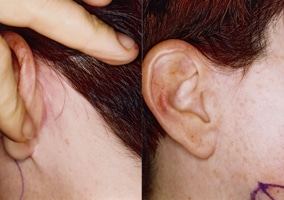
Typical near-invisible facelift scars produced by Dr. Haworth.

Typical near-invisible facelift scars produced by Dr. Haworth.
5. WHAT IS FIBRIN GLUE?
This is a true advance in facelift surgery in that it dramatically reduces the postoperative bruising and swelling associated with the procedure. As an added benefit, it allows the surgeon to forgo the use of annoying drains after surgery while virtually eliminating the chance of hematoma formation. It is a human-derived plasma product tested for HIV and hepatitis and used extensively in cardiac and neurosurgery. In facelift surgery, it is sprayed on all the raw surfaces to seal off most blood vessels and lymphatic channels not visible to the naked eye. This latter effect accounts for the rapid initial recovery seen in my facelift patients along with my use of electrocautery to perform most of the dissection. Electrocautery dissection eliminates most blood loss during surgery, further minimizing postoperative bruising and swelling.
6. HOW LONG IS THE SURGERY AND WHAT ARE THE THE MOST COMMON RISKS WITH IT?
A regular facelift without browlift, eyelid or lip surgery takes about 3 to 3.5 hours to perform. A midface lift takes about one hour to perform. With modern anesthesia it is all exceptionally safe surgery, however, regular facelift surgery patients need to be monitored by a healthcare professional for the first night after the procedure. This is most commonly done in a specialized aftercare facility. The reason for this is to check for the early signs of a hematoma (a blood collection under the facial skin), probably the most common complication after a facelift. Despite it being a very rare occurrence (especially with the use of fibrin glue), it is important to catch it early if it does occur so that it can be corrected rapidly.
7. WHEN CAN I GO IN PUBLIC?
Most patients are “restaurant-ready”, perhaps with some strategic coverup in about 7-10 days. This time period will be longer if you get your lips enhanced at the same time. Most stitches are removed at 5 days and the last hidden ones are removed at 10.
8. HOW MUCH PAIN WILL I BE IN DOCTOR?
Actually, very little. All facial procedures (including regular and midface lifts) are normally associated with some degree of numbness, stiffness and tightness. Stiffness with minor impairment of your full denture smile can last up to 3 months while sensation starts returning after a couple of weeks. Despite the lack of pain we still administer pain medicine just in case you need it.
9. WILL I LOSE ANY HAIR?
With the modern techniques of facial rejuvenation and specialized modifications that I have developed, hair loss is a very rare occurrence. However, if a small patch of hair loss develops it is an easy thing to correct.
10. HOW LONG WILL MY FACELIFT LAST?
Regular facelifts last from 7-12 years, depending on the individual’s tissue makeup. It is not that facelift suddenly falls apart at 12 years, but you will gradually note that the general signs of aging start to catch up again around this time. “Plastic surgery reverses time, but time still marches on.” – Dr. Haworth.



